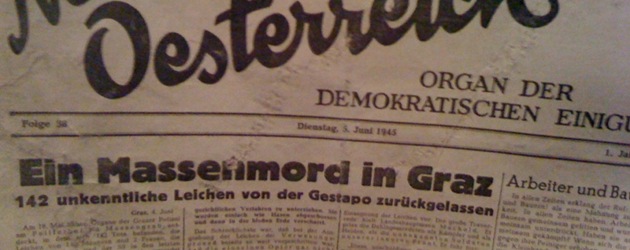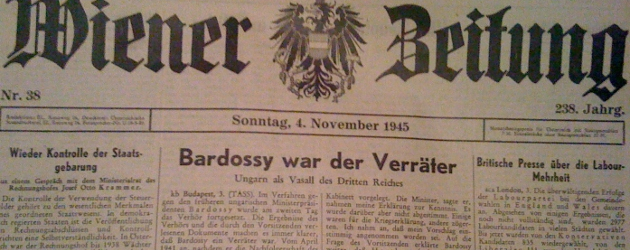Amateur history nerd that I am, I’m quite pleased to have married into a family which has retained all sorts of books, newspapers and magazines dating from about 1920 onwards. The “In the Hausarchiv” series gives an occasional look at the things I’ve come across in our own “house archive”.
Last Wednesday’s “In the Hausarchiv” featured a post-war edition of the Wiener Zeitung. Today I do something similar by featuring the 5 June 1945 edition of “New Austria” (Neues Oesterreich), “the organ of democratic unification” (Organ der demokratischen Einigung).
I believe this is the earliest post-war edition of a newspaper here in the Hausarchiv. Given that this edition is numbered 38, one presumes it was being published as early as late April 1945, which would have been quite soon after the Red Army had entered Vienna (ca. 13 April 1945).
Because the paper has no information concerning its publisher, and considering the moniker “organ of democratic unification”, I thought it safe to conclude that this was the newspaper published by the provisional government. A visit to the online Austrian encyclopedia project, aeiou, confirmed this:
Neues Österreich, first Austrian post-war newspaper set up on April 23, 1945 as the “voice of democratic agreement”. The Austrian People’s Party (ÖVP), the Austrian Social Democratic Party (SPÖ) and the Austrian Communist Party (KPÖ) were responsible for its contents …
(You can see that their translation of “Organ der demokratischen Einigung” differs from the translation I came up with before finding their entry on the topic. When in doubt, go with theirs not mine!)
In this edition of Neues Oesterreich, the lead headline reads, “Mass murder in Graz: 143 unidentifiable corpses left behind by the Gestapo” (my translation). The article concludes that these corpses belonged to prisoners held by the Gestapo and the SS and that, rather than being shown any mercy, these prisoners were simply murdered just before their captors fled from the approaching Red Army. Only one body could be identified, that of Dr. Julia Pongracic.
Most interesting from the historical perspective is the account of the speech by the governor of Styria (where Graz is located), given at the memorial service for these victims. In the speech, the governor, Reinhold Machold, underscores Austrian resistance to National Socialism, as well he might do, given that the Soviets were occupying his part of Austria. Compared to the occupation zones of the other three Allies, the Soviet zone was rather more punishing in the sense that the Red Army uprooted and physically moved to the Soviet Union much machinery and other equipment for industrial production. After emphasizing Austrian resistance, Machold concludes:
We would hope and plead that the victors [the Allies], for whom we are grateful for freeing us from this Nazi pest, shall keep this in mind as they decide the fate of our poor, plagued, tormented, unhappy Austrian Volk. [my translation]
(Wir wollen hoffen und wir bitten darum, daß die Sieger, denen wir dankbar dafür sind, daß die uns von dieser nazistischen Pest befreit haben, dies bedenken und in Rechnung stellen mögen, wenn sie endgültig über das Schicksal unseres armen, geplagten und gepeinigten, unglücklichen österreichischen Volkes entscheiden werden.)
The question of seeing Austrians as Mittäter oder Opfer (perpetrators or victims) is a big one, and one which I will no doubt write about here someday.





